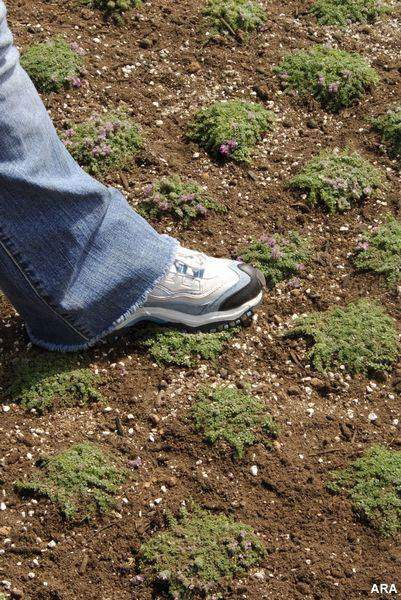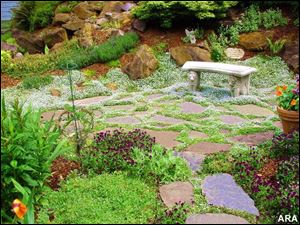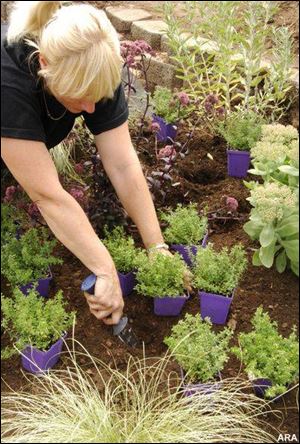
Pass on the Grass
7/24/2008
Creeping perennials have thousands of tiny, compact root nodes that firmly grasp the soil, says Fran Hopkins, founder of Stepables. As often as you step on them with the soles of your feet, they will vigorously take root; the more they are walked on, the faster they will creep across the landscape space.
(ARA) - A welcoming, lush and green lawn is something to be proud of, but the challenges of maintaining such a lawn can be tough for the greenest thumb. Where traditional turf fails in the landscape, using creeping perennials is an alternative that is both ornamental and functional.

This former lawn has been transformed into a quiet garden sanctuary with Isotoma fluviatilis Blue Star Creeper , from Stepables, intermittently planted between the stepping stones.
"Almost every homeowner has an area in the landscape where grass just won't grow," says Frances Hopkins, founder and CEO of Under A Foot Plant Company. "Creeping perennials provide the solution for these problem areas."
Creeping perennials should not be likened to common groundcovers, though it is easy to confuse the two. "The difference is definitive," Hopkins says. "Groundcovers grow much larger at 12 to 24 inches and do not make for a pleasant walking surface. Creepers will grow only about 2 to 4 inches creating a pleasant, low visual plane typically associated with a lawn, plus they are sturdy enough to handle foot traffic."
Stepables, Hopkins' line of more than 140 creeping perennial varieties, provide solutions for troublesome landscapes. "Creeping perennials have thousands of tiny, compact root nodes that firmly grasp the soil," Hopkins says. "As often as you step on them with the soles of your feet, they will vigorously take root; the more they are walked on, the faster they will creep across the landscape space."
Plant Selection
First, it's important to decide how much you are going to use the planted area. "Foot traffic and function are among the most important considerations when selecting lawn replacement alternatives," Hopkins says. Light foot traffic means someone will be walking on the creeping perennials one to two times per week; moderate is one to two times per day, and heavy is three or more times per day. When choosing plants, the denser a plant, the more traffic it will take.
Therefore, a list of specific areas including expected levels of walking and strolling is a good, initial means to a successful change from grass to this type of planting. Curb appeal is another important consideration related to improving a home's landscape and overall appearance.

Deciding how dense to plant creeping perennials depends on how much money is in the budget and if instant gratification is a priority. Plant most varieties 2- to 12-inches apart. The plant tags contain instructions, and a plant spacing calculator is online at www.stepables.com.
"Think about the elements of decor -- brick, slate, concrete, paint color, and color schemes," Hopkins says. "Make plant choices that work well with the surroundings."
With these considerations in mind, the next step is choosing the right plants for the area's environmental conditions. Hopkins says the No. 1 thing to look for is sun to shade ratio and where the light hits. Next, homeowners are able to find out their soil quality by taking a sample to a local garden center for analysis. Based on the results, garden center employees can help choose a soil amendment, which ideally should be something with excellent drainage. Correct drainage is described as allowing an appropriate amount of water absorption by the plant's roots, while also permitting excess water to be drained away from the plant.
The Turf Transition
Making the transition from a conventional grass lawn to one with creeping perennials takes planning. Be sure you choose the proper plant for the area and function, and one that has plenty of availability from the local garden center. Next, determine the density of the plants. Spacing them 12 inches apart, for example will require fewer plants, but they will take a year or more to fill in and need a bit of maintenance. Spacing plants just 2 inches apart will require more plants, costing more. Deciding how dense to plant creeping perennials depends on how much money is in the budget and if instant gratification is a priority.
The next step is removing the sod, and tilling and amending the soil with high-drainage components. Once the bed is ready, consider placing a slow-release fertilizer at root level.
"Do not place fertilizer directly on the plant because this will burn the foliage," Hopkins says. To avoid hand weeding, homeowners may opt to apply a ground cloth or pre-emergent herbicide, though creeping perennials naturally inhibit weeds. For best results, plant creeping perennials even or just above the soil line, but never below. Planting below the soil line will cause water to collect and, ultimately, drown the plants, Hopkins says.

Creeping perennials have thousands of tiny, compact root nodes that firmly grasp the soil, says Fran Hopkins, founder of Stepables. As often as you step on them with the soles of your feet, they will vigorously take root; the more they are walked on, the faster they will creep across the landscape space.
Step On It
The final step is just that: gently step on each plant to set it in place and get it started growing.
"Believe it or not, gently stepping on each new plant actually attaches the roots to the soil line. In about three days, little roots will emerge from the nodes," Hopkins says.
As with traditional lawns, the more thought, planning, effort and care that homeowners put into installing a bed of creeping perennials, the more it will pay off in the end with the long-term benefit of a beautiful, functional landscape with far less maintenance and more time to simply enjoy it.
Courtesy of ARAcontent